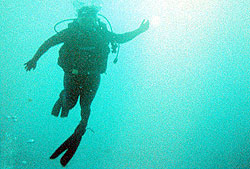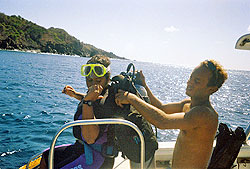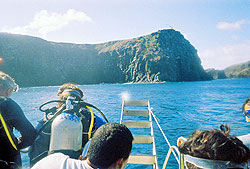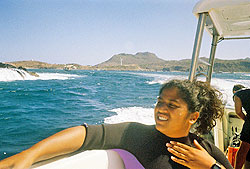 |
NOVEMBER 3, 2005
CAGARRAS FUNDAS
115 FEET (32M)
Atlantis Divers
Cagarras Fundas is a
deep dive along the northwest coast of
Fernando de Noronha, an island off the
northeast coast of Brazil. It is a
deep dive, with a maximum depth of 32m
(115 feet).
|
Named for the rocky crags
that extend down into the water, we found
visibility here to be fairly average at around
65 feet (20m). Clarity we understand
improves much more in the winter months (April
to November), and lessens in the Summer months
(December to March). The water color is a
nice pale blue - similar to that in the Florida
Keys, but with better visibility. There is
no coral at this site - the rocky shores are
what attract the fish.
There are three people with our
divemaster, including us - Atlantis says no more
than four people to a divemaster. He explains
to us that if we're lucky, we'll see a barracuda,
and we'll see a lot of fish (we had explained to
the shop that Sandra likes to see fish - apparently
they took that into consideration). The water
is fairly rough on the surface, but very calm down
below. Our gauges are in the metric system,
but our divemaster explains how to use them to measure
our air. The rental gear is good quality and
apparently well-maintained.
Almost immediately upon descent,
we spot a huge spotted eagle ray, then a group of
massive barracuda. Throughout the dive, we
see dozens of barracuda, along with a wide variety
of tropical fish, including many large varieties
of parrotfish, angelfish, and many fish we had never
seen before. We also had a nice hawskbill
sea turtle sighting which is always fun. We're
struck by the average size of the fish, which is
much larger than in Mexico. I guess they eat
well.
Overall, this dive site was pretty
good - lots of marine life, nice smooth, calm, water,
good visibility, varying depths for varying life,
and all those BIG barracuda.
| |
|
| |
|
 |
NOVEMBER 3, 2005
RESURRETTA
50 FEET (15M)
Atlantis Divers
Ressurretta is a
shallow dive site along the coast of the
Fernando de Noronha Archipelago off the
northeast coast of Brazil. With a
maximum depth of 15m (50 feet), this is
a nice second dive. This day,
there was a lot of surge on the surface
as well as down below.
|
A drift dive, the current
wasn't much of a problem, but the surge was a
little frustrating, though not too big of a
deal. The visibility was near 100 feet, about
average for this time of year. The clarity
increases during the winter months (April to
November) and decreases during the summer months
(December to March), at least according to our
divemaster aboard the Fly n Dive.
Located along a narrow channel
between islands, the water was very choppy on the
surface - I'm amazed I didn't get sick. Once
below, the surge continued, but it was workable.
There was no coral at this site - the marine life
congregated for the craggy rocky slopes entering
the sea. Right away for the second dive in
a row, we spotted a huge spotted eagle ray.
This one just floated slowly, allowing us to follow
it and observe it for quite some time.
Later in the dive, we spotted
an 8-foot nurse shark asleep under an overhang -
exposed in profile - a real treat. Under another
overhang we saw two very large spiny lobsters, and
a couple of small crabs. Then suddenly a giant
green moray swam by us, slowly against the surge.
It was probably about 8 feet long. Later,
another big green moray showed us it's head out
of the rocks. A large stingray lay on the
bottom for us to see, and later another one was
spotted under an overhang.
The abundant and very large marine
life at this site more than made up for the surge
and lack of coral. There were many types of
sponges and seaweed here, but not much other color
except for that of the parrotfish, angelfish, sergeant
majors, and large schools of jacks. We had
a bottom time of about 40 minutes and still had
1000 psi of air left at the end of the dive.
After boarding the boat, I got
sick briefly as usual, chummed over the side, then
was fine. As we headed back to the marina,
we spotted a pod of about 20 spinner dolphins off
the side of the boat - another treat in a good afternoon.
| |
|
| |
|
 |
NOVEMBER 4, 2005
-
PONTA DE MACAXEIRA - 160 FEET (45M)
Atlantis Divers
Ponta de Macaxeira is a deep dive site at
the far North end of the Fernando de Noronha
Archipelago. Ponta de Macaxeira
is a massive rock wall dive with strong
currents and heavy surge at the water's
surface and depths of over 45m (160
feet).
|
The rock wall extends from
Rata Island, where the mix of currents meeting
at the northern point of the island chain
provides not only for unique visibility, but
also for an amazing array of marine life.
This is definitely an advanced dive - even being
on the boat on this day wasn't for the feint of
heart or weak of stomach. Those who endure
are treated to an exciting descent down a sheer
rock face with massive numbers of fish and other
marine life.
The waves were huge as the boat
was tossed around forcefully - we were all a little
green in the face as we hurriedly donned our gear
and hurled ourselves into the torrid surface.
We descended immediately to avoid the strong surface
current, which quickly subsided as we reached about
5m (15 feet). Sandra and I had some trouble
clearing our ears, so we were still descending when
the rest of our group spotted a large nurse shark
swimming free.
Once at a depth of about 40m
(130 feet), we started along the face of the wall
as the current grew in intensity. Looking
up, we could see the water filled with fish, silhouetted
against the sunlit surface of the water like something
out of a scuba diving magazine. The rocky
crags were filled with fish, but we didn't see any
larger life near the wall area. Venturing
out onto the ocean floor, we found a stingray with
a large fish swimming above it and a nurse shark.
Continuing on, primarily marveling at the wall itself,
we rose to 30m (100 feet) and then after a while
up to 15m (50 feet).
Now as we turned the corner around
the end of the wall, the current became very strong
and we had some difficulty swimming against it.
We churned away from the wall and across a current-ridden
channel to where we started our ascent back to the
boat. After our safety stops, as we neared
the surface, we saw the ladder wildly thrashing
side to side. We grabbed at the ladder and
tried to stay on as it whipped strongly in all directions.
Eventually, we got back on the boat and we all looked
a little green - wishing for less tumultuous waters.
Overall, this dive site was quite
interesting - a huge variety of fish life, despite
very few pelagic sitings and a lack of coral or
other such organisms. The wall itself was
quite impressive, and we definitely saw potential
for better sightings in the future.
| |
|
| |
|
 |
NOVEMBER 4, 2005
RESURRETTA
45 FEET (13M)
Atlantis Divers
This was the second day in a row we dove
this site, but this time we circled the
small inlet in a counter-clockwise
direction, and saw the other side.
The dive was just 13m (45 feet) in depth
- a good second dive depth.
|
Overall, this area was not
very interesting - a few overhangs to look under
to no avail, and a lot of avoiding other divers.
Although Atlantis had told us there would be no
more than 4 divers to a divemaster when we had
signed up, there were 6 of us with him that day.
This made a crowded scene when there wasn't much
to see - when we spotted a stingray, lobsters,
or one of two nurse sharks, or an eagle ray,
divers were piling all over each other,
especially when two beginner groups were diving
the same site at that time - there were a lot of
divers in a small area, and that was not cool.
Apparently there weren't a lot
of shallow dive sites in that area or something,
because to dive an overcrowded site that everyone
on the boat had already dove that trip, we were
all a bit disappointed. We did see a boat
anchor that had rusted several different colors,
along with the whole line still intact, now covered
with barnacles, but the other divers seemed more
interested in that than we were.
For more details on the Ressurreta
dive site, please see our first-dive roundup of
Ressurretta Fernando de Noronha a couple of paragraphs
up the page.
Once on the boat, we chatted
it up with a couple of Norwegian divers who had
been diving for the last five days. They raved
about a couple of sites on the far side of the island,
calling one of them the best dive they'd ever had.
Apparently you had to dive more than two days to
get to dive sites of that quality, but we enjoyed
the dives we had for the most part. The only
disappointing part was diving the same site two
days in a row.
|